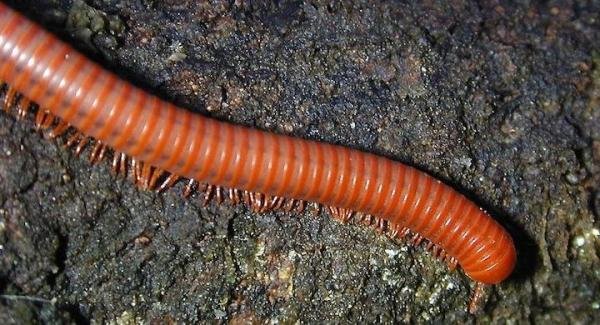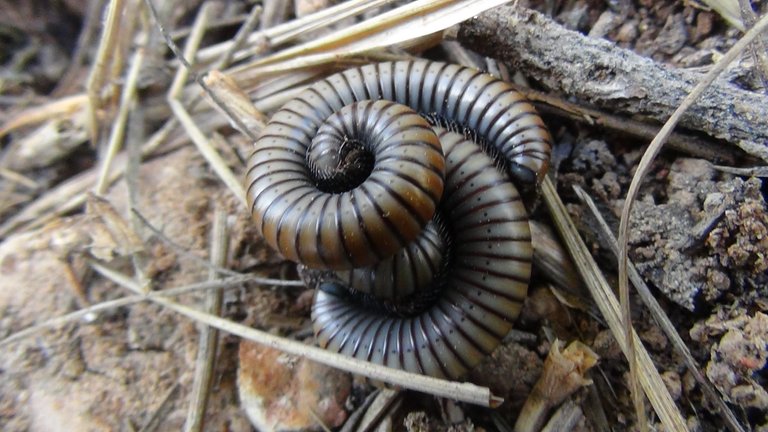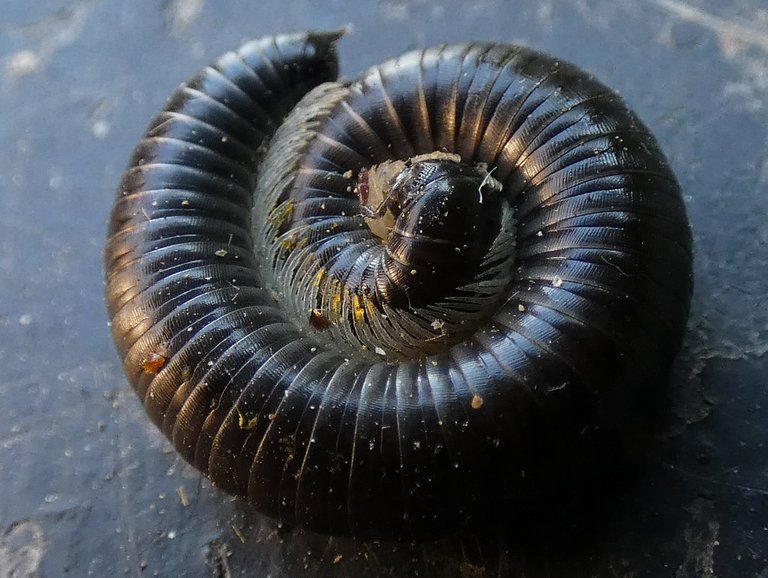Hello friends of Steemit, today I bring you an article where I will tell you about the millipede. But will it be true that it has a thousand feet? We will know next.
 Source
Source
The millipede (diplópodos) is a class of known myriapods and the maximum number of legs of a millipede does not exceed 750, and most have less than 200; even so, the millipede is the insect with the most legs.
 Source
The millipedes have the body divided into two regions is the head and the trunk. The head has a pair of short antennae, the simple eyes and the mouthparts, the jaws being in some species very modified as excavating instruments. The trunk has many segments and most have two pairs of legs (from which derives its scientific name), except the first and the last, which do not have, and the second, third and fourth, which only carry a pair of legs each . The duplicity of the legs is a consequence of the merger of two consecutive segments into one of only one, so we can speak of diplosegments instead of segments. Unlike centipedes (chilopoda), millipedes lack a venom inoculating device, but many diplopods have a row of glands on their sides that secrete pestilent and irritating chemicals when they are disturbed, which can cause eruptions on human skin.
Millipedes are predatory species and their diet is based on hunting small insects and small invertebrates.
Source
The millipedes have the body divided into two regions is the head and the trunk. The head has a pair of short antennae, the simple eyes and the mouthparts, the jaws being in some species very modified as excavating instruments. The trunk has many segments and most have two pairs of legs (from which derives its scientific name), except the first and the last, which do not have, and the second, third and fourth, which only carry a pair of legs each . The duplicity of the legs is a consequence of the merger of two consecutive segments into one of only one, so we can speak of diplosegments instead of segments. Unlike centipedes (chilopoda), millipedes lack a venom inoculating device, but many diplopods have a row of glands on their sides that secrete pestilent and irritating chemicals when they are disturbed, which can cause eruptions on human skin.
Millipedes are predatory species and their diet is based on hunting small insects and small invertebrates.
 Source
The reproduction of the millipede occurs between spring and summer. These animals have oviparous type reproduction and build nests for that purpose. As an adaptation to reproduction, the relationship between males and females of millipedes is very unbalanced in favor of females. They can be raised in a group, provided they are of the same species. In addition, each time they grow they add a new segment, this does not happen in the majority of animals that end their development once the embryonic development has passed. This means that the final number of rings in the millipedes is not reached until after the larval life. They have 8 segments when they have just been born and 12 when they reach adulthood. When they are moving from skeletons they usually do not eat during the process.
Source
The reproduction of the millipede occurs between spring and summer. These animals have oviparous type reproduction and build nests for that purpose. As an adaptation to reproduction, the relationship between males and females of millipedes is very unbalanced in favor of females. They can be raised in a group, provided they are of the same species. In addition, each time they grow they add a new segment, this does not happen in the majority of animals that end their development once the embryonic development has passed. This means that the final number of rings in the millipedes is not reached until after the larval life. They have 8 segments when they have just been born and 12 when they reach adulthood. When they are moving from skeletons they usually do not eat during the process.
They inhabit the humidity and flee from the light. During the day they hide among the leaf litter, under stones or between the bark of the trees. Many millipede species live in caves because they are places that fulfill these requirements very well. Very rarely do we see it in domestic homes due to the lack of low luminosity and humidity.
Their method of defense is based on coiling themselves to protect themselves. They can be wound spirally (julidos) or ball-shaped (gloméridos), which can confuse the latter with the cochineal of moisture.
 Source
Large tropical species can cause many problems in humans and domestic animals when they come into contact with them, such as blindness.
Source
Large tropical species can cause many problems in humans and domestic animals when they come into contact with them, such as blindness.
http://wikifaunia.com/invertebrados/milpies/
Truly, the animal world never ceases to amaze us, be careful to see one. Remember that they can be toxic to the health of the human being. Thank you for taking your time, if you found it interesting, follow me and you will find more articles like that. I hope to have your vote.




The creatures have many legs look it horrible
Hi @nghiatrong if only I had knowledge of the cienpies. But this surprised me more.
You got a 1.81% upvote from @minnowvotes courtesy of @adriamguillen!